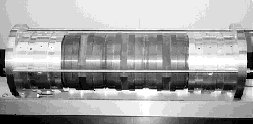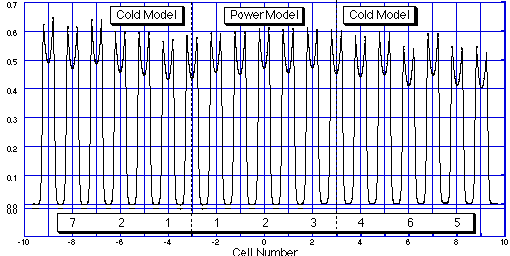A high power model of the biperiodic L-support DAW
for electron acceleration is fabricated and under test. Two 1.2m
long accelerating tubes are coupled by a bridge coupler, which
has an RF coupler, a vacuum port, and three frequency tuners.
Each end of the bridge-coupled tube set is terminated by a full-cell
endplate for the accelerating mode. The operating frequency is
S-band so that the DAW accelerating tube can replace a conventional
disk-loaded-waveguide accelerating tube for high power tests.
The mechanical design and the measured parameters are described.
An electron linac [1] has been installed at the Accelerator
Laboratory, Institute for Chemical Research, Kyoto University.
Its use is mainly intended as the injector for the electron storage
ring KSR [2, 3], which is being assembled. Three of 3-m disc-loaded
wave-guides are installed as the accelerator tubes, which are
operated at 2857MHz. By replacing one of the wave-guides with
a new accelerating tube with a higher shunt impedance and the
higher accelerating gradient, the output energy can be increased
with the same input RF power.
A cold model made of Aluminum was fabricated to study the characteristics of the DAW structure with biperiodic L-supports [4]. Based on the results from the cold model tests, a high power model was designed and three units of the power model have been fabricated.
Figure 1 shows the schematic drawing of the power model. Because of the biperiodicity of the structure, one unit of the power model contains a disk-ring and a unit frame with two washers supported by L-supports. The unit frame is reversible with 90_ rotation. The unit frames and the L-supports are made of chromium copper for the mechanical strength. In order to have the cooling water channel, the washer is divided into two OFC (Oxygen Free Copper) parts, which are brazed together in a furnace. The L-supports are bent pipes with the thickness and the diameter of 1mm and 6mm, respectively. Two washers and four L-supports are brazed on the frame. Photo 1 shows the unit frame.


The disk-ring is inserted between two unit frames, where the RF contact is achieved by 0.2mm hight knife edges on the inner corners of the unit frames. The seam between two unit frames will be welded together. The disk-ring is made of OFC, and has four 2 mm x 2 mm evacuation grooves on the outer surface so that the space between the knife edges and the welded seam is open to the inside. The whole assembly is covered by a stainless steel pipe, and cooled by water jacket. Cooling water comes from outside of the jacket pipe to the washers through the pipes screwed on the frames and through the L-supports. The other ends of the L-support-pipes on the outer surface of the unit frames are open to the water jacket. Two outlet ports are located on the outer surface of the stainless steel jacket pipe. The assembled accelerating tube has longitudinal symmetry with 90_ rotation so that the direction can be reversed for an improvement of the electric field distribution.
Two of the accelerating tubes are coupled by a coaxial bridge coupler, which has an evacuation port and frequency tuners. The RF power is fed through the coupling slot on the coaxial bridge coupler. The spool in the bridge coupler is supported by four straight pipes connected to the body of the bridge coupler, so that the cooling water can go through the spool. The electric field distributions in the bridge coupler for the accelerating mode and the coupling mode are shown in Fig. 3 and Fig. 4, respectively.



Three of the power model units are fabricated for
mechanical investigations. Each accelerating mode frequency is
measured with two half cell endplates. The half cell endplates
are made of Aluminum, so as not to distort the edges on the unit
frame much. A unit frame is put between the half cell endplates,
and the stack is pressed by six M8 bolts at the torque of up to
150 kg cm (see Photo 2) . The results are shown in Table I. The
estimated Q-value by SUPERFISH is 21000, which does not include
the power loss on L-supports. Although the surface of the washer,
which is made of OFC as stated before, seems clean, the surface
of chromium copper looks dark, which may be one of the reason
of the low Q-value. The conductivities on the chromium copper
and aluminum are assumed as 70% and 65% of that on copper, respectively,
which may not be accurate enough for us to compare the absolute
value of the Q-value.

Table 1 Measured accelerating mode frequency and
Q-value.
All the three units are stacked together with two aluminum alloy disk-rings inserted in between, and the accelerating mode frequency is measured as 2858.083 MHz.
The measurement of the coupling mode frequency is not as easy as the accelerating mode frequency, because of the termination problem. Strictly speaking, the measurement of even the accelerating mode frequency does not show the right biperiodic configuration, because the half cell endplate gives mirror symmetry, and then the configuration is quad-periodic. The L-supports do not perturb the accelerating mode much, and then the periodicity problem should not be serious on accelerating mode. The coupling mode frequencies are being evaluated combining with the cold model cells.
The electric field distributions are measured by
the bead-pull perturbation method. The three-stacked unit frames
are put between the cold model cells (see Photo 3). The measured
electric field distribution for a configuration of nineteen accelerating
gaps is shown in Fig. 5. The electric field distribution in the
power models is smoother than that in the cold model, which shows
the higher mechanical precision of the power model than that of
the cold models.


We are accumulating the technical knowledge for building the high power structure through these experiments. Because the duty factor for this particular application is very low (less than 10-4), the heat problem may not be so serious. Simulation studies on the water flow, the heat transfer, and the thermal expansion are scheduled.
The present work is supported by Grant-in Aid for
Scientific Research from Ministry of Education, Science, Sorts
and Culture Government of Japan. The power model units are manufactured
through collaborations with Mitsubishi Heavy Industries, LTD.
and Nuclear Development Corporation.
[1] T. Shirai, et al., "A 100 MeV Injector for the Electron Storage Ring at Kyoto University", Proc. of the 1995 Particle Accelerator Conference, Dallas, p. 1079 (1995)
[2] A.Noda, et al., "Electron Storage Ring, KSR for Light Source with Synchrotron Radiation", Proc. of the 1995 Particle Accelerator Conference, Dallas, p. 278 (1995)
[3] A.Noda et al., "Electron Storage and Stretcher Ring, KSR", Proc of the 1996 European Accelerator conference, Barcelona, in print.
[4] Y.Iwashita, et al., "Cold Model Test of
Biperiodic L-Support Disk-and-Washer Linac Structure", Proc.
of the 1995 Particle Accelerator Conference, Dallas, p. 1093 (1995)